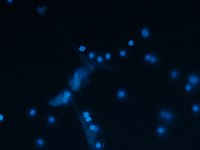
Photo from wikipedia
Objectives: To investigate the relationship between prognosis, changes in mitochondrial calcium uptake, and bioenergetic status in the heart during sepsis. Design: In vivo and ex vivo controlled experimental studies. Setting:… Click to show full abstract
Objectives: To investigate the relationship between prognosis, changes in mitochondrial calcium uptake, and bioenergetic status in the heart during sepsis. Design: In vivo and ex vivo controlled experimental studies. Setting: University research laboratory. Subjects: Male adult Wistar rats. Interventions: Sepsis was induced by intraperitoneal injection of fecal slurry. Sham-operated animals served as controls. Confocal microscopy was used to study functional and bioenergetic parameters in cardiomyocytes isolated after 24-hour sepsis. Electron microscopy was used to characterize structural changes in mitochondria and sarcoplasmic reticulum. The functional response to dobutamine was assessed in vivo by echocardiography. Measurements and Main Results: Peak aortic blood flow velocity measured at 24 hours was a good discriminator for 72-hour survival (area under the receiver operator characteristic, 0.84 ± 0.1; p = 0.03) and was used in ex vivo experiments at 24 hours to identify septic animals with good prognosis. Measurements from animals with good prognostic showed 1) a smaller increase in mitochondrial calcium content and in nicotinamide adenine dinucleotide fluorescence following pacing and 2) increased distance between mitochondria and sarcoplasmic reticulum on electron microscopy, and 3) nicotinamide adenine dinucleotide redox potential and adenosine triphosphate/adenosine diphosphate failed to reach a new steady state following pacing, suggesting impaired matching of energy supply and demand. In vivo, good prognosis animals had a blunted response to dobutamine with respect to stroke volume and kinetic energy. Conclusions: In situations of higher energetic demand decreased mitochondrial calcium uptake may constitute an adaptive cellular response that confers a survival advantage in response to sepsis at a cost of decreased oxidative capacity.
Journal Title: Critical Care Medicine
Year Published: 2017
Link to full text (if available)
Share on Social Media: Sign Up to like & get
recommendations!